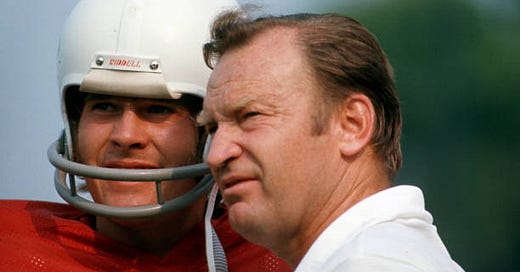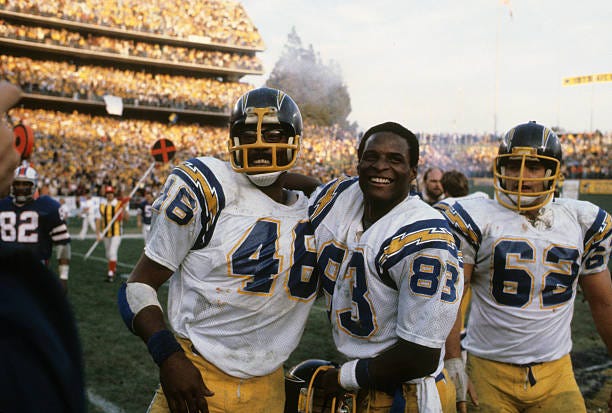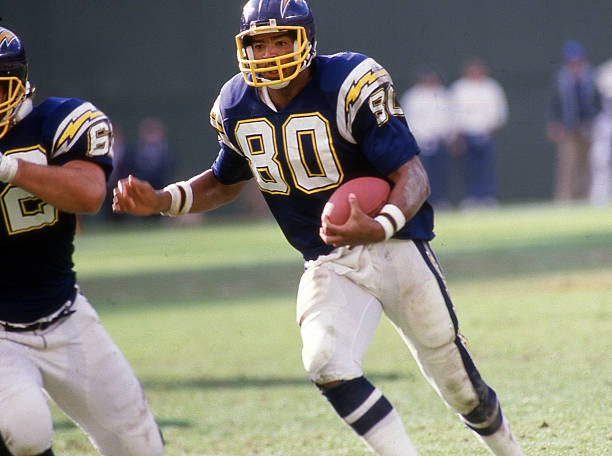2023 Hall of Fame class, part 1: Coach Don 'Air' Coryell's San Diego Chargers lit up the NFL in 1980
Editor’s note: This is the first article in a four-part series profiling 2023 Pro Football Hall of Fame inductees Don Coryell, Joe Klecko, Ken Riley and Zach Thomas. Each installment will highlight one of these inductees’ best seasons. We kickoff the series this week with a look at coach Coryell’s 1980 season with the San Diego Chargers and their nearly unstoppable offense.
If you like watching the modern NFL with four and five wide receiver sets, quarterbacks constantly lining up in the shotgun, high-octane offenses and teams racking up 30 and 40 points per game, you can thank one man: Don “Air” Coryell.
Considered the “Godfather” of the modern passing game, the coach brought his “Air Coryell” scheme when he came to the St. Louis Cardinals in the early 1970s. After a successful run as head coach at San Diego State, St. Louis hired Coryell to turn around its dismal franchise in 1973. It didn’t take him long to place the Cardinals on the right path. St. Louis finished 10-4 in ‘74, falling to the Minnesota Vikings in the NFC Divisional Round Playoffs.
In ‘78, Coryell returned to San Diego to coach the wayward Chargers, almost immediately turning around the organization. San Diego, led by 28-year-old quarterback Dan Fouts, improved from 9-7 to 12-4 in ‘79, capturing the AFC West Division title. The Chargers’ high-powered offense was grounded in the playoffs, however, falling 17-14 to the Houston Oilers in the second round.
In 1980, the Air Coryell attack really started clicking. Finishing 11-5, San Diego held off the powerful Oakland Raiders to recapture the AFC West crown. The Raiders would have the last laugh, though, outlasting San Diego 34-27 in the AFC Championship Game.
While they were denied the Super Bowl in ‘80, there’s no question the Chargers had an offensive juggernaut. San Diego scored 418 points and led the NFL in total yards with 6,410. Three players—wide receivers John Jefferson and Charlie Joyner, along with tight end Kellen Winslow—were All-Pro selections. Fouts, sparked by a league-leading 4,715 yards, made the Pro Bowl.
Narrator John Facenda summed up the Chargers’ aerial assault perfectly with the opening line of the team’s 1980 NFL Films highlight package: “Deep in the canyon of Mission Valley, there lies the most potent source of strength in professional football.”
Running back Chuck Muncie was also a key contributor, rushing for 659 yards and four touchdowns in 11 games. While the passing offense received most of the glory, San Diego’s ground game was formidable. Muncie, along with backfield mates Mike Thomas, John Cappelletti and Clarence Williams rushed for more than 100 yards nine times during the season.
Coryell’s offense relied on several weapons to keep defensives wary-eyed and worn out.
“Fouts was given carte blanche with the three most productive receivers ever to play on a single team,” said Facenda. “Everyone shared in the Chargers’ passing explosion.”
Jefferson had a monster season: 82 receptions, a league-leading 1,340 yards receiving and 13 touchdowns. The wideout became the first receiver in NFL history to collect 1,000 yards in each of his first three seasons.
“He made catches that must be considered… state of the art,” Facenda said.
Winslow paced the league in receptions with 89 for 1,290 yards and 9 TDs, while Joyner, a 33-year-old veteran, hauled in 71 catches for 1,132 yards and 4 TDs. Winslow’s reception total was the most ever by a tight end and he was the first TE in 13 years to chalk-up more than 1,000 yards.
The Air Coryell attack was designed to spread out the offense with multiple receivers and stretch the defense to the breaking point. Instead of using Winslow as a traditional tight end, tasked with run blocking and maybe catching a pass here and there, Coryell utilized the 6-foot-5 Winslow more as a wide receiver. With the speedy Jefferson and the sure-handed Joyner lined up on the outside and Winslow marshaling the middle of the field, who exactly does the defense cover? The scheme made it difficult to double-cover one receiver, since Fouts had multiple options.
“The thing that makes our offense pretty unique is that we’re going to send five receivers into the pattern each time,” Fouts told NFL Films. “Any one of those five is capable of being the receiver. The thing about it is, none of those five have the idea that they are the primary receiver.”
The Chargers kicked off the ‘80 season red hot, winning their first four games. Offensively, they scored 30 or more points in three of those contests. San Diego’s finest afternoon came on Oct. 19. In a 44-7 dismantling of the New York Giants, the Chargers piled up 567 total offensive yards on 31 first downs. Fouts fired three TD passes and racked up 444 yards, completing 26 of 41 throws. The three-headed monster of Jefferson, Joyner and Winslow each surpassed 100 receiving yards with Jefferson leading the charge with 10 receptions for 171 yards and a TD.
Throughout the ‘80 season, Coryell’s offense hummed, topping 400 yards in nine games, including the conference title loss to the Raiders.
San Diego hit a few roadblocks in the middle of the season and sat at 6-4 after a loss to Denver. The Chargers rebounded to win five of their last six games, building a head of steam for the playoffs. In the divisional round, San Diego held off the scrappy Buffalo Bills, 20-14, before falling to Oakland a week later.
San Diego’s defense gets overshadowed looking back on the Coryell years, but the Chargers had a few playmakers on the other side of the ball, too. Along the defensive line, All-Pros Gary Johnson (17.5) and Fred Dean (10.5) combined for 28 sacks. Defensive tackle Louie Kelcher (5.5 sacks) also made the Pro Bowl. In the backfield, safeties Glen Edwards (5) and Pete Shaw (4) swiped nine interceptions.
Despite his offensive genius and innovation, Coryell never coached in the Super Bowl. The early ‘80s Chargers are one of those “what could have been” teams in NFL lore. San Diego returned to the AFC title game in 1981, falling to the Cincinatti Bengals 27-7 in the “Freezer Bowl.” A week earlier, the Chargers survived—barely—with a 41-38 overtime victory over the Miami Dolphins in the divisional round. Playing in pea-soup thick humidity, the Chargers triumphed in a classic in South Florida.
Coryell’s near misses likely prolonged his invitation to football immortality. However, Coryell, who died in 2010 at age 85, still produced an impressive resume. According to ESPN, he was the first head coach to win 100 games in both college and the pros. He grew a sturdy coaching tree, highlighted by hall-of-famer Joe Gibbs, Coryell’s offensive coordinator for two years in San Diego and, before that, his running backs coach in St. Louis. As a head coach, Gibbs won three Super Bowls in Washington— with three different quarterbacks—taking bits and pieces of Coryell’s offense to develop his own attack.
Coryell’s offense led the league in passing seven of his eight seasons in San Diego. It’s been more than 35 years since Coryell coached his final game, but his imprint is still felt today.






